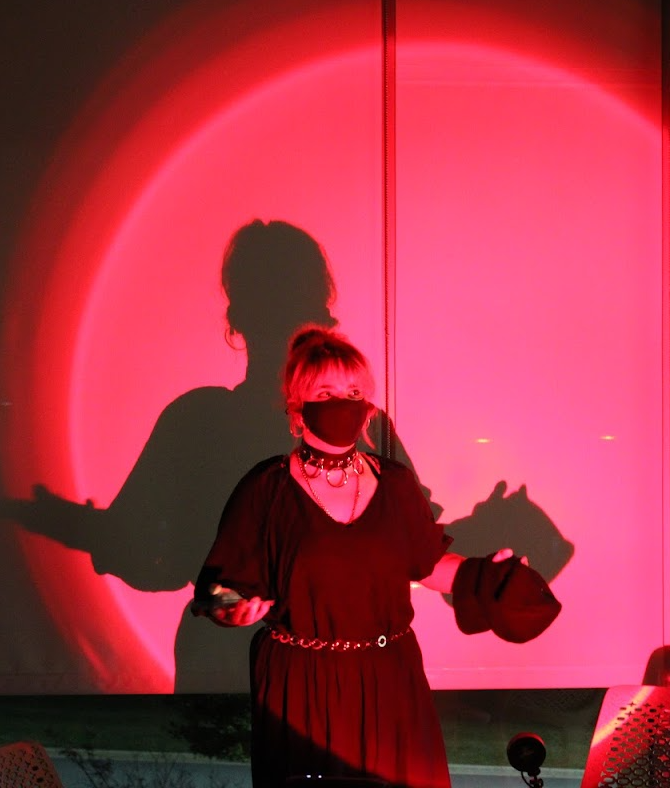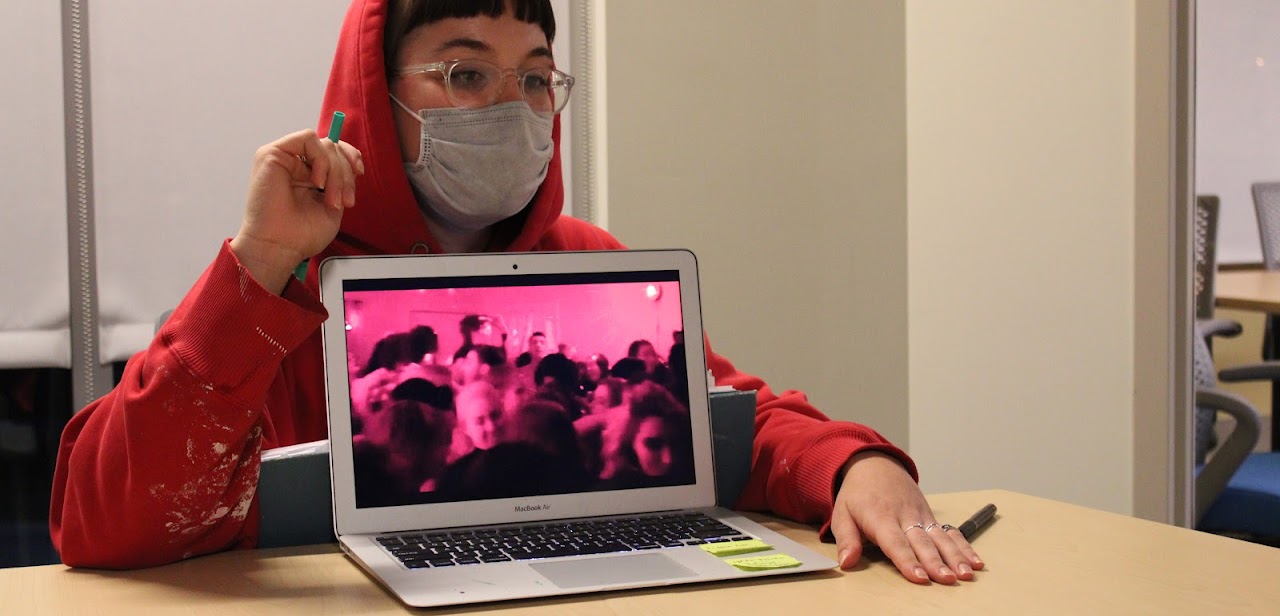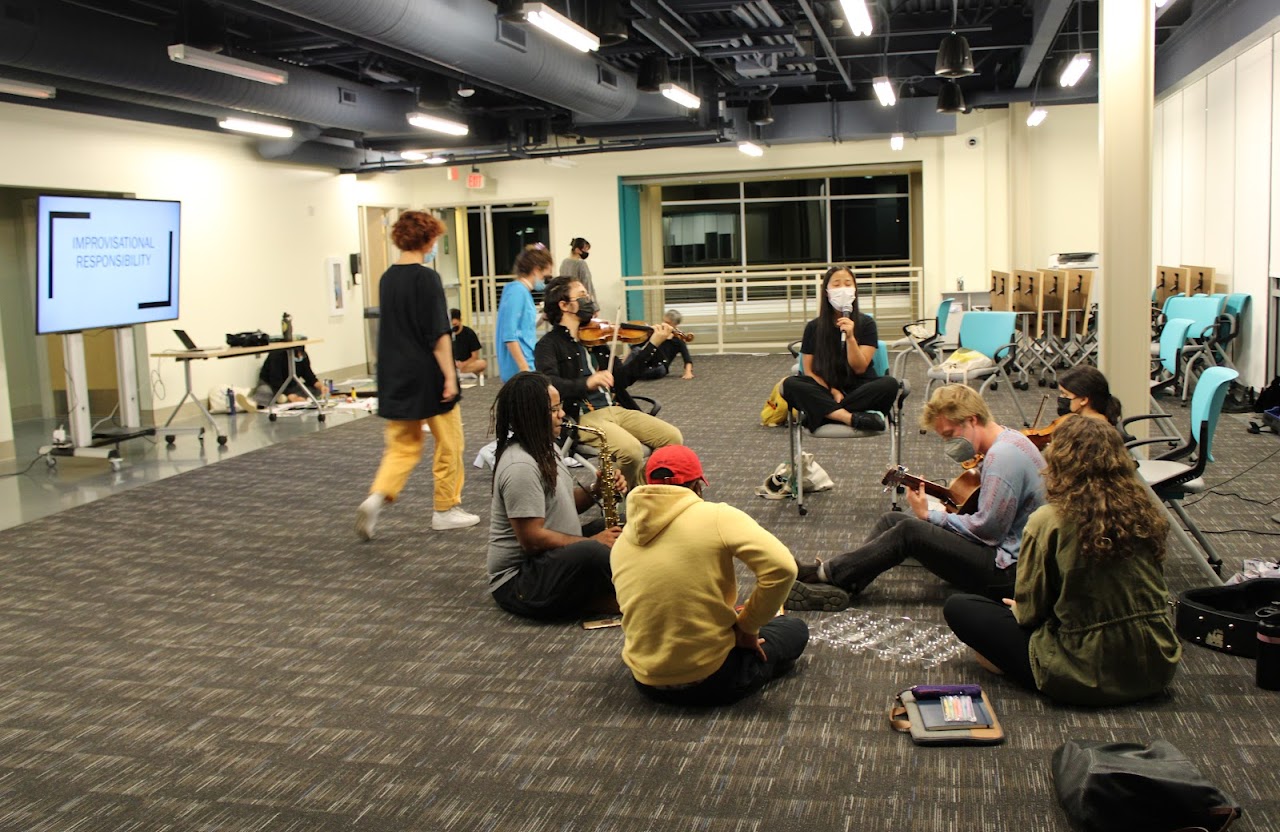Studio for Creative Practice: supporting individual research and art making practice across the disciplines.
STUDIO 2021-2022
“The environment and the structure of studio was concerned with having each individual artist have everything that they need to follow their own instincts and impulses; by that I mean the tools, the spaces and the people to support them in their own individual work. At the same time, you put those individuals in a space where other people are doing the same thing, so that every creation is subject to change…That’s where all the magic happens in studio: where the individual instincts and projects overlap.”
Collaborators in Studio for Creative Practice 2021-22 experienced pinnacle success in the shape of transdisciplinary, student-agency driven, wellness-centered creative research immersion for students across all arts schools at UNCSA. The tenets that underpin the design of Studio, including an unwavering belief in each student’s ability to take ownership of their learning and to establish methods of creative practice, with ongoing support and guidance from faculty, proved highly effective in the outcomes students experienced. After four years of design and pilot iterations, Studio for Creative Practice achieved a full and dynamic expression of its original vision this year.
Studio for Creative Practice cultivates students’ capacities as generative artists committed to research, impact, and contemporary relevance. Teaching practices center on nurturing student agency and activating an equitable learning environment with a goal, in part, of cultivating innovative and engaged artist-citizens. Studio for Creative Practice equips students with the skills and confidence needed to dialogue within and across disciplines and to facilitate entry into a variety of cultural conversations and artistic pursuits.
This year, Studio took place throughout the Center for Design Innovation building, testing the use of the flexible, spacious environment. CDI provided an inspiring architecture for the program, and student projects animated the spaces for different audiences and engagements including experimental film, multimedia installation, immersive performance and improvisational music and movement.
STATS 21/22
I felt extremely supported by the faculty and never felt judged – they offered guidance in helpful ways that were true to what I needed personally. If I needed them to feed my artistic seeds, they would do that. If I asked for opinions, they’d offer them. If I asked for purely technical notes, they gave them.”
Faculty and Artist Participants: Mollye Maxner, Abby Yager, Betsy Towns, Andy Paris, Chris Yon, Taryn Griggs; supported by Andrew Britt, Kirtan Coan, Temple Crocker, Nickolay Hristov, Ingrid Kapteyn, Anson Koch-Rein, Reagan Mitchell, Matthew Nielson, Michael Rohd, and Ana Claudia dos Santos Sao Bernardo.
Here’s what we set out to do, and here are some of the outcomes that exceeded our hopes and expectations
In the 2021-2022 year, Studio for Creative Practice was able to:
- Serve 17 students in the fall and 12 students in the spring from all five arts schools through the two Studio for Creative Practice courses;
- Offer training in transdisciplinary art-making, collaboration, dramaturgy for new transdisciplinary work, community connection, and critique practices, through a high-impact model that balances student agency and community responsibility.
- Provide ample space and time for discussion, reflection, collaborative work, critique, and making new work on a daily basis
- Offer a significant number of individual artistic advising hours outside of official class time (often 20 hours a week, a key to Studio’s support of emerging transdisciplinary performance makers) and a class faculty/student ratio of between 1:17 and 1:4 depending on the class session.
- Advise and support the creation of over 80 transdisciplinary art “studies,” shared and discussed through collaborative critique practices weekly in Studio, as well as a myriad of developed iterations for public sharing, including those listed below under Public Sharing.


PUBLIC SHARING
“Studio directly impacted how I perceive my work … through the method of showing each week … That peeled back judgment, especially judgment of my moving body as a dancer. I can come in with less judgment of what I look like, instead thinking about all the elements in the space… instead of thinking of them as defaults. [Now I recognize that] they can all be actively be decided and thought about.”
This year, faculty advised and support the creation of myriad developed iterations for public sharing, including:
- The creation of an improvisational band, named Pennies for Breakfast, comprised of two Music students and two Drama students. Pennies for Breakfast shared three public performances this year (reaching over 50 people) and scored and performed the music for a Drama Mainstage production (Mother Tongue, reaching over 400 people). They are continuing their collaborative work and performance post-graduation through the further development of the band, live performances, and an upcoming EP.
- The premiere iteration of Mother Tongue, conceived and directed by a directing student from the School of Drama (reaching over 400 people). The seeds for Mother Tongue sprouted in Studio in 2020, were developed in Studio and in Andy Paris’ devised course over an 18-month period, and culminated in a mainstage production through the School of Drama. Music was scored and performed by Pennies for Breakfast. Set design was done by a Design and Production student who was also a student in Studio. The director of Mother Tongue received a grant from the Semans Art Fund for her research in Brazil in 2021 and additional funding from the Semans Art Fund for her continued work on this impactful project in 2022.
- A 2.5 hour movement installation conceived and performed by two Dance students for an audience of over 85 students and faculty
- A site-specific installation inspired by two plays by Samuel Beckett (reaching approximately 45 people)
- Five film and movement performance/installations (reaching approximately 50 people, collectively)
- Three interactive, multimedia visual art installations (reaching approximately 30 people)
- A 30-minute 2-person musical, soon to be expanded to a 45-50 minute musical which received a grant from the Semans Art Fund for 2022
- The emergence of three singer-songwriters (from Drama and Film) who are now performing in public; including one with an album to be released in June;
- The inception of a craft enterprise: a Dance student built inventory, secured exhibition booth, designed the space, articulated financial model, and sold original craft works
- A Film student in Studio created two exhibitions in NYC at EV Gallery in Manhattan: “Methods of Execution” in January, with attendance approximately 250, and “Do You Surrender” in March, with estimated 350 attendees.




“All the artists we were introduced to, the artworks and content that we were exposed to, made us think about the arts and craft and making and knowing you’re in a space with artists who were having these thoughts and getting inspired by each others’ work”

Responsive Pedagogies
- Create a robust pedagogy for transdisciplinary art-making, collaboration, dramaturgy for new transdisciplinary work, community connection, and critique practices, through a high-impact model that balances student agency and community responsibility.
- Provide ample space and time for discussion, reflection, collaborative work, critique, and making new work on a daily basis
- Enable in-depth “encounters” for students of work from artists across the globe doing work relevant to the students’ research. These “encounters” included videos, films, readings, interviews, in-person art exhibits and performances, and live sessions with guests.
- Bring in 10 guest artists/thinkers directly relevant to the students’ research. These artist/thinkers came from UNCSA, the Winston-Salem community, and across the country
- Attended performances or sharings in all art schools, visited museums, attended readings, lectures, and public performances.
- Support the grant writing skills of Studio students (75% of Advanced Studio students submitted grant applications this spring). Studio students received cumulatively over $12,500 in grants this spring, as well as four fellowships or residencies (in New York City, Washington DC, and Greensboro NC)
- Serve students in the final semester whose chosen life/career paths diverge from the norm at UNCSA, through dialogue, advising, and shared research into options aligned with their interests.

- Serve faculty at UNCSA through weekly anti-bias sessions that included readings, discussions, and processes to unpack the ways bias show up in classrooms. Faculty expressed direct and positive impacts on their teaching from these sessions.
- Serve students and faculty by creating a space where process leads the way, where values can be stated and actioned individually and in community, freeing the creative mind to move into new territory, as per the interests of the students with support from faculty.
- Develop an impactful approach to teaching that we are calling Responsive Pedagogy. In our pedagogical model we develop artist capacity in a structure where each week, each day, and even each hour the curriculum is crafted in response to the people in the room.
RESEARCH AREAS
- language as a means of expression and obfuscation
- language and translation
- language and gender identity
- gender and the public bathroom
- improvisation, listening, and sound perception
- queerness and monsters
- honeybees and the hive mind
- the impacts of proscribed cultural and social meaning to sound
- waste picking in Brazil
- waste, decay of waste, relationship between waste and deterioration
- cyclical storytelling and deterioration of plot
- play, playfulness, and the childhood imagination
Faculty and invited guest supported student inquiry into varied topics including:
